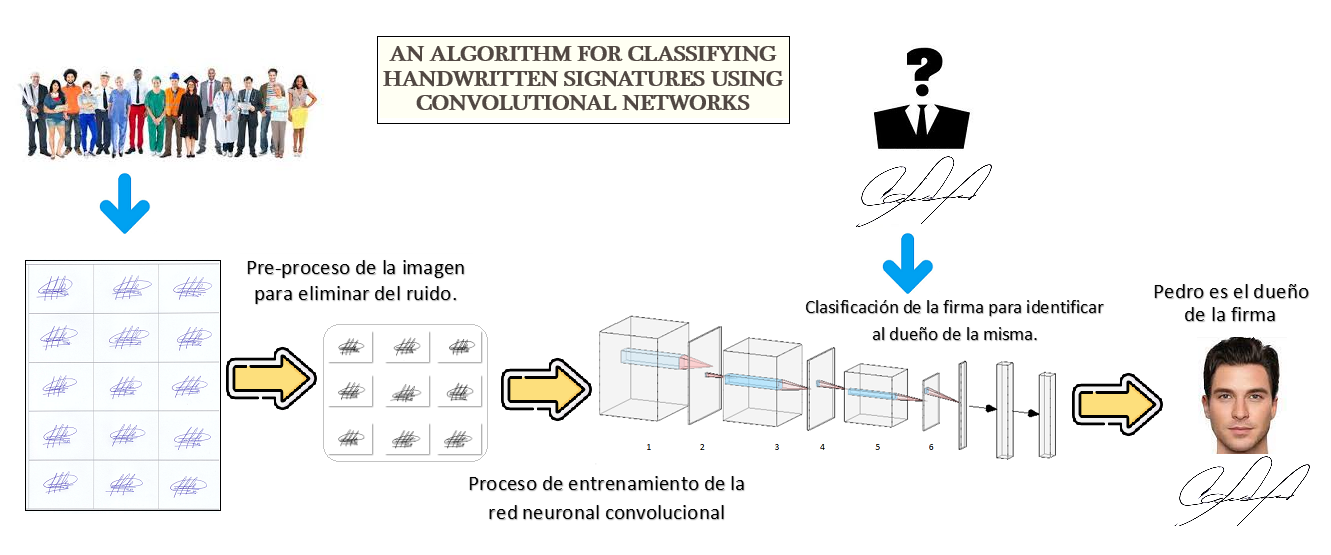An Algorithm for Classifying Handwritten Signatures Using Convolutional Networks
Keywords:
Convolutional neural networks, Handwritten signature classification, Offline signature recognitionAbstract
In this study, a model based on convolutional neural networks is proposed to quickly and efficiently classify and identify a person's signature with over 90% accuracy. For this purpose, two signature datasets were used. The first, called CEDAR, is publicly available. The second set, called GC-DB, was collected by the researchers using uncontrolled environments (different signing positions). This dataset has 121 local signatories from the Republic of Ecuador, who submitted 45 copies of signatures each. In this set of signatures, the implicit noise produced by the capture device and by the paper of different thicknesses used in the collection made noise removal a relatively complex operation. The effectiveness of the proposed algorithm was compared with two other algorithms that were implemented and validated using the two data sets. The results show that it is possible to perform an efficient classification of handwritten signatures with the developed algorithm. Additionally, the developed algorithm is lightweight and easy to implement and can be installed on portable devices such as cell phones or tablets.
Downloads
References
R. K. Mohapatra, K.Shaswat, and S. Kedia, “Offline handwritten signature verification using CNN inspired by Inception V1 architecture,” in Proceedings of Fifth International Conference on Image Information Processing (ICIIP), pp. 263-267, 2019.
R. Palacios and A. Gupta, “A system for processing handwritten bank checks automatically,” Image and Vision Computing, vol. 26, nº 10, pp. 1297-1313, 2008.
M. Miah, M, Yousuf, and S. Mia, “Handwritten Courtesy Amount and Signature Recognition on Bank Cheque using Neural Network,” International Journal of Computer Applications, vol. 118, nº 5, pp. 20-26, May 2015.
V. Ruiz, I. Linares, A. Sánchez, and J. Velez, “Off-line handwritten signature verification using compositional synthetic generation of signatures and Siamese Neural Networks,” Neurocomputing, vol. 374, nº 1, pp. 30-41, September 2019.
P.Agrawal, D. Chaudhary, V. Madaan, A. Zabrovskiy, R. Prodan, D. Kimovski, and C.Timmerer, “Automated bank cheque verification using image processing and deep learning methods,” Multimedia Tools and Applications, vol. 80, nº 1, pp. 5319-5350, October 2020.
Ecuador, Banco Central, “Boletín informativo trimestrral de sistemas de pago, cuarto trimestre,” BCE, Quito, 2019.
E. Alajrami, A. M. Ashqar, S. Abu-Nasser, A. Khalil, M. Musleh, A. Barhoom, and S. Abu-Naser, “Handwritten Signature Verification using Deep Learning,” International Journal of Academic Multidisciplinary Research (IJAMR), vol. 3, nº 12, pp. 39-44, December 2019.
L. Hafemann, R. Sobourin, and L. Olivera, “Learning features for offline handwritten signature verification using deep convolutional neural networks,” Pattern Recognition, vol. 70, nº 1, pp. 163-176, 2017.
S. Chandra and S. Maheskar, “Offline signature verification based on geometric feature extraction using artificial neural network,” 2016 3rd International Conference on Recent Advances in Information Technology (RAIT), pp. 410-414, 2016.
O. Rosso, R. Ospina, and A. Frery, “Classification and Verification of Handwritten Signatures with Time Causal Information Theory Quantifiers.,” Plos One, vol. Vol. 11., nº 12., pp. 1-19, 2016.
L. Hafemann, R. Sabourin, and L.Oliveira, “Offline Handwritten Signature Verification,” Seventh International Conference on Image Processing Theory - Literature Review, Tools and Applications (IPTA), pp. 1-8, 2017.
J. Pinzón-Arenas, R. Jiménez-Moreno, and C. Pachón-Suescún, “Offline signature verification using DAG-CNN,” International Journal of Electrical and Computer Engineering (IJECE), vol. 9, nº 4, pp. 3314-3322, August 2019.
S. Wang and S. Jia, “Signature handwriting identification based on generative adversarial networks,” Journal of Physics, vol. 1, nº 1, pp. 1-5, 2019.
R. Ghosh, “A Recurrent Neural Network-based deep learning model for offline signature verification and recognition system,” Expert Systems With Applications, vol. 168, nº 1, pp. 1-31, 2021.
K. Lakshmi and S. Nayak, “Off-line Signature Verification Using Neural Networks.,” Proceedings of the 2013 3rd IEEE International Advance Computing Conference, IACC, pp. 1065-1069, 2013.
J. Anamika, S. Satish Kumar, and S. Krishna Pratap, “Handwritten signature verification using shallow convolutional neural network.,” Multimedia Tools and Applications, vol. 79, nº 1, pp. 1-23, 7 April 2020.
S. Sam, K. Kamardin, N. Sjarif, and N. Mohamed, “Offline Signature Verification Using Deep Learning Convolutional Neural Network (CNN) Architectures GoogLeNet Inception-v1 and Inception-v3,” Procedia Comput Science, vol. 161, nº 1, pp. 475-483, 2019.
Z. Zeng and J. Tian, “Deep Learning Methods for Signature Verification,” arXiv:1912.05435v1, vol. 1, nº 1, p. 12, 8 December 2019.
M. Lopez-Martin, S. Le Clainche, and B.Caro, “Model-free short-term fluid dynamics estimator with a deep 3D convolutional neuronal network,” Expert Systems With Applications, vol. 177, nº 1, September 2021.
K. Kancharla, V. Kamble, and M. Kapoor, “Handwritten Signature Recognition: A Convolutional Neural Network Approach,” 2018 International Conference on Advanced Computation and Telecommunication, ICACAT 2018, pp. 8-12, 2018.
S.N. Gunjal, B.J. Dange, and A.V. Brahmane, “Offline Signature Verification using Feature Point Extraction,” International Journal of Computer Applications, vol. 141, nº 14, pp. 6-12, 2016.
J. Naider, Z. Alqadi, and B Zahran, “Analysis of Color Image Filtering Methods,” International Journal of Computer Applications, vol. 174, nº 8, pp. 12-17, Septiembre 2017.
Y. Zhu and C. Huang, “An Adaptive Histogram Equalization Algorithm on the Image Gray Level Mapping,” International Conference on Solid-State Devices and Materials Science, p. 601 – 608, 2012.
M.Yapıcı, A.Tekerek, and N. Topaloğlu, “Deep learning-based data augmentation method and signature verification system for offline handwritten signature,” Pattern Analysis and Applications, vol. 16, nº 4, pp. 165-179, 2021.
E. Roe and C. Mello, “Binarization of color historical document images using local image equalization and XDoG,” International Conference on Document Analysis and Recognition, 2013.
T. Rabbi, S. Rahman, P. Biswash, J.Kim, A.Sheikh, A.Saha, and M.Uddin, “Handwritten Signature Verification Using CNN with Data Augmentation.,” Journal of Contents Computing, vol. 1, nº 1, pp. 25-37, December 2019.
S. Pratt, A. Ochoa, M. Yadaw, A. Sheta, and M. Eldefravy, “Handwritten Digits Recognition Using Convolutional Neural Networks,” The Journal of Computing Sciences in Colleges, vol. 34, nº 5, pp. 40-46, 5 Abril 2019.
Z. Xiong, Y. Cui, Z. Liu, Y. Zhao, M. Hu, and J. Hu, “Evaluating explorative prediction power of machine learning algorithms for materials discovery using -fold forward cross-validation,” Computational Materials Science, vol. 171, nº 1, pp. 1-11, Enero 2020.


